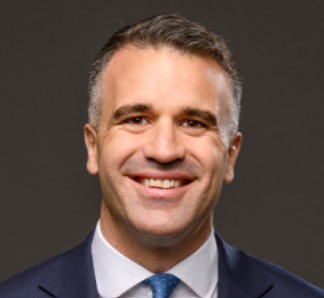The largest and most complex infrastructure project in South Australian history is underway in Adelaide.
Heavy machinery arrived at the Southern Precinct in Clovelly Park last week signalling the start of construction and the commencement of major works on the River Torrens to Darlington project that will create a non-stop South Road.
It’s estimated up to 550 workers will be employed at the Southern Precinct during peak construction; ten times that number – 5,500 – will be needed during the course of the $15.4 billion project, which is jointly funded by the federal and the state government with each contributing $7.7 billion each.

“The partnership between my state government and the Albanese federal government really is on show here. I am very pleased that we are getting this project done,” SA Premier Peter Malinauskas said at a press event at the site, which will see two 90 metre-long tunnel boring machines lowered 25 metres below the surface to start tunnelling in the second half of 2026.
“I cannot possibly overstate the size and the complexity of this $15.4 billion project,” added Malinauskas. “This is one of the biggest engineering undertakings that’s not just occurred in the history of our state but indeed the nation. This is the biggest infrastructure project in Australia right now.”
I cannot overstate the size and the complexity of this project
Slated for completion in 2031, the South Road project marks the final stretch of the North-South Corridor – a 78km non-stop, traffic light-free motorway.
Once South Road is open to traffic, motorists will be able to bypass 21 sets of lights through four sets of tunnels between the River Torrens and Darlington, saving up to 40 minutes of peak-hour travel time on one of Adelaide’s most important arterial roads.
“Forty minutes – that’s a big number,” Malinauskas said. “And when you add that up for every single working family, every single day of the week, it means hours and hours of people’s lives that are returned to a better standard of living, which is exactly why this project requires urgency.”
But the legacy of the project will not just be a faster commute for tens of thousands of motorists, Malinauskas added, “It’ll actually be changing the economic dynamic of the way our city operates, which is exactly why this is worth it in the long run.”




Excellent use of public money. That will make a huge difference for commuting to Flinders Uni. It sure is painful now.
What about the condition of the main roads between Adelaide Sydney and Melbourne outrageous. Tearing up cars and trucks and taking lives. That messes up your quality of life also.
It’s all well and good that a main arterial road is being built but what about some funding for our farmers? When will the Federal and SA State governments declare a drought emergency so our farmers can access assistance? Why is our State Government only focusing on Adelaide and not the rest of the State?
What do you call Whyalla then you fool. Inner city? If that is not regional assistance I don’t know what is.
So the tunnel works are going so well in Victoria, This is going to be fraught with danger, and when the unions get involved, budget and time blow-out is guaranteed…
One good sure way to bankrupt the state, welcome to southvicbankrupt Australia….
Nothing like a farmer wanting a subsidy at every turn. What have farmers been doing in the ‘good times’ to prepare for the tougher times.
It will be near that figure as long as certain regimes are kept out of it. As soon as they have any involvement you can guarantee the figure will be double what you have ‘predicted’!
This government need to do what the ‘Iron lady’ of the UK did all those years ago!
Hard to understand why we are still making huge investments in unsustainable road transport and not building a sensible network of railways for mass transit and goods movement between centres and rural towns.
Only issue is it will remove another 5500 housing building construction workers from building urgently needed houses which are needed more than government infrastructure projects which should only be built on a large scale during depressions and times of high unemployment. Again government spending is crowding out the private sector house building market and drive up the cost of materials to build houses. Leading to even more homelessness. Australia needs a Big Housing Build not Big government infrastructure builds at the expense of not housing a growing population. People can’t live in bridges and tunnels. Government priorities are all wrong. There is a lack of Goal Congruence between the needs of people and the government.
Should start at the other end – all the new home estates being built at north and expresseways from Gawler and Port Wakefield all fed into Thebarton carpark every morning, it’s an express carpark and getting worse every month.
The T2D project is much needed… The financial benefits and environmental benefits are long overdue not to mention the removal of the eyesore that Sth Road has been.
In my Governments of all persuasions, have been gamed by private sector companies building government infrastructure while state governments public sector expertise is now reduced to contract mgt at arms length; guaranteeing inflationary end results.. the oversight and cost management and administration of these major projects is driven by the contractors and their effectively, extortionate rates and consequences for the state budget long term.. insourcing of key elements of future major infrastructure projects must be considered to ensure L/T improvements in cost management. This is notionally “good debt” and further equivalent scale economic development infrastructure projects are needed in regional SA including upgrades to rail and roads.. A housing construction workforce requires a short medium and long term strategy …The government claims they are doing the work.. it may require skilled trades immigration from the phillipines and other culturally suitable countries to manage the short term needs?
Cannot wait for the completion. I will now be able to work in the southern suburbs without a 3 hour drive, 1.5 hrs each way.
Progress Yes. With the current mix of narrow roads and heavy vehicles. This section if this major road is increasingly hazardous to all have to use it or cross it
This investment will transform the suburbs surrounding this section from ugly ,dangerous
Into a better human friendly part of Adelaide
Increasingly the home of more Australians